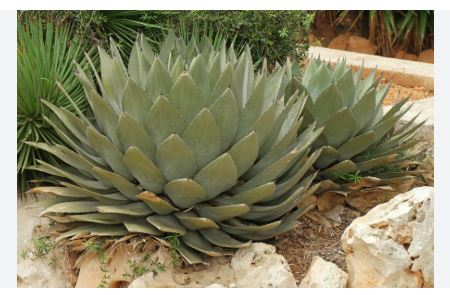
The Butterfly Agave (Agave potatorum) is a captivating succulent native to the semi-arid highlands of Mexico, particularly between Puebla and Oaxaca. This agave earns its whimsical name from the butterfly-shaped markings that adorn its leaves. These markings can range in color from a soft, powdery blue-green to a striking silvery white.
This plant has compact, symmetrical rosettes of broad, glaucous blue-gray leaves. Each leaf is adorned with short, reddish-brown marginal spines on tubercle-like prominences and a longer, often somewhat wavy terminal spine. The rosettes can grow up to 2 feet tall and 3 feet in diameter. The leaves terminate in a sharp, often twisted, reddish spine.
Agave potatorum is relatively low-maintenance and thrives on a bit of neglect. It prefers full sun but can tolerate light shade, especially in areas where the afternoon sun is intense. This agave is hardy in USDA zones 9b to 11b, withstanding temperatures from 25°F (-3.9°C) to 50°F (10°C)1. It is essential to provide well-draining soil and avoid overwatering, as the plant is susceptible to root rot if left in soggy conditions.
The Butterfly Agave is not only admired for its ornamental value but also for its resilience and adaptability. It can be grown both outdoors in suitable climates and indoors as a potted plant. When grown indoors, it is crucial to place it in a sunny window and ensure it receives adequate light to thrive. Additionally, the plant’s thick, sturdy leaves and sharp spines make it a robust and visually appealing choice for succulent enthusiasts
Beyond its aesthetic appeal, the Butterfly Agave holds cultural significance in its native Mexico. It has been used for centuries by indigenous communities for its fibers, which are used to make textiles and cordage. Additionally, the plant’s sap has been traditionally used to produce a fermented beverage known as pulque.
Characteristics
- The Butterfly Agave is a small to medium-sized succulent, forming a symmetrical rosette with wavy, blue-gray to silvery-green leaves.
- The leaves have prominent reddish-brown spines on their edges and a sharp terminal spine at the tip, adding to its ornamental appeal.
- The rosette typically grows to about 12–24 inches (30–60 cm) in height and width, making it ideal for container planting or small gardens.
- It is a slow-growing plant, taking several years to reach maturity, which enhances its longevity in landscapes or pots.
- The plant is monocarpic, producing a tall flowering stalk up to 10–20 feet (3–6 meters) at the end of its life cycle.
- The flowers are tubular and range in color from yellow-green to red. After flowering, the parent plant dies, leaving offsets for propagation.
- Native to Oaxaca, Mexico, it thrives in semi-arid regions with rocky or sandy soil.
- The plant can live 8–15 years before flowering, depending on environmental conditions.
- Hardy in USDA zones 8–11, it can tolerate mild frost but should be protected from prolonged freezing temperatures.
Cultivation of Butterfly Agave (Agave potatorum)
Sunlight Requirements
The Butterfly Agave thrives in full sun to partial shade, depending on the climate. In regions with intense, scorching sunlight, providing some afternoon shade can prevent leaf scorch. When grown indoors, place it in a bright location, such as near a sunny window or in a greenhouse with adequate light.
Soil Needs
This agave prefers well-draining soil, such as sandy or gritty mixes, to mimic its natural rocky habitat in Mexico. Avoid heavy, clay-rich soils, as poor drainage can lead to root rot. If planting in pots, use a succulent or cactus-specific soil mix, or amend regular soil with coarse sand and perlite.
Watering Practices
The Butterfly Agave is a drought-tolerant plant that requires minimal watering once established. During the growing season (spring and summer), water sparingly, allowing the soil to dry completely between waterings. In winter, reduce watering further to match its dormancy period and avoid waterlogging, which can harm the roots.
Temperature Tolerance
This agave is best suited for warm, arid climates, thriving in USDA hardiness zones 8–11. While it can tolerate short periods of mild frost (down to about 25°F/-4°C), prolonged exposure to freezing temperatures can damage the leaves. In colder regions, it’s best to grow the plant in a container so it can be moved indoors during winter.
Fertilization
The Butterfly Agave requires minimal feeding, but light fertilization during the growing season can encourage healthy growth. Use a diluted, balanced fertilizer or a succulent-specific product once a month in spring and summer. Avoid over-fertilizing, as this can lead to weak, overly rapid growth.
Propagation Techniques
Propagation is primarily done through offsets (pups), which grow at the base of mature plants. These can be removed and replanted once they are large enough. Allow the offsets to dry for a day or two after separation to prevent rot before planting them in well-draining soil. Propagation from seeds is possible but slower and less commonly practiced.
Pest and Disease Prevention
While the Butterfly Agave is relatively hardy, it can be affected by pests such as agave snout weevils and mealybugs. Regular inspection and good airflow around the plant can help prevent infestations. Overwatering is a common issue that can lead to root rot or fungal diseases, so ensure proper drainage and avoid water sitting in the rosette.
Landscaping and Care Tips
The Butterfly Agave is a versatile plant that fits well in rock gardens, xeriscapes, and container arrangements. Its compact size and ornamental foliage make it an excellent focal point in any landscape. Minimal pruning is required, though damaged or dead leaves should be removed to maintain its appearance and health. With proper care, this agave will thrive and add elegance to any garden or indoor space.